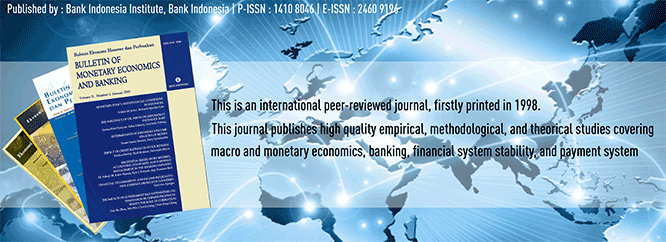
Document Type
Article
Abstract
In a free floating rate system, the exchange rate is determined directly by market forces, and is liable to fluctuate continually, to follow changing market condition. This system assumes the absence of any systematic government intervention in the foreign exchange market, so exchange rate will move freely in response to market force. It mean that exchange rate is determined by fundamentals, risk, and exchange rate (Rp/US$) expectation factor.The purpose of this research is to identify the problems of the correlation of fundamental factor (like is differences of interest rate, relative prices rate, Real GDP, money supply, net foreign assets, foreign direct investment, foreign indirect investment, external debt growth, payment of private external debt, export, and import), risk factor (country risk index), and expectation of exchange rate (Rp/US$) against rupiah’s exchange rate after applying the freely floating exchange rate system in august 14, 1997. This research use time series for 52 months, which is period September 1997 until December 2001.This study use two kinds of model, that is; (a) cointegration equation model, and (b) dynamic model; Error Correction Model (ECM). The estimated completed by the test of classic assumptions, and validation test of ECM.Based cointegration analysis and Error Correction Model (ECM) against research model, have the result that for 52 months (1997:9-2001:12), that differences of interest rate, relative prices rate, net foreign assets, foreign direct investment, foreign indirect investment, external debt growth, payment of private external debt, export, country risk index, and expectation of exchange rate (Rp/US$) have correlation against rupiah’s exchange rate in short and long terms, except Real GDP, money supply, and import only have correlation against rupiah’s exchange rate in long term.Determination for research model, with cointegration equation model is bigger then ECM method. This give the indication that in long term variation of hypothesis independent variable more able explained than variation of dependent variable (rupiah’s exchange rate) compare with in short term.Keyword : Exchange Rate, Fundamentals, Risk, and Exchange Rate Expectation Factor
Recommended Citation
Suhendra, Indra
(2003)
"PENGARUH FAKTOR FUNDAMENTAL, FAKTOR RESIKO, DAN EKSPEKTASI NILAI TUKAR TERHADAP NILAI TUKAR RUPIAH (TERHADAP DOLLAR) PASCA PENERAPAN SISTEM KURS MENGAMBANG BEBAS PADA TANGGAL 14 AGUSTUS 1997 (PERIODE SEPTEMBER 1997 S.D. DESEMBER 2001),"
Bulletin of Monetary Economics and Banking: Vol. 6:
No.
1, Article 3.
DOI: https://doi.org/10.21098/bemp.v6i1.322
Available at:
https://bulletin.bmeb-bi.org/bmeb/vol6/iss1/3
First Page
34
Last Page
57
Creative Commons License

This work is licensed under a Creative Commons Attribution-NonCommercial 4.0 International License
Country
Indonesia
Affiliation
Bank Indonesia







